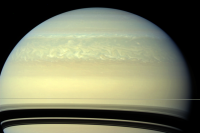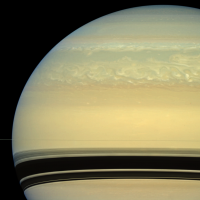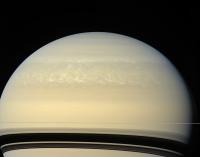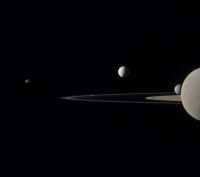Printable Version of Topic
Click here to view this topic in its original format
Unmanned Spaceflight.com _ Cassini's ongoing mission and raw images _ Rev 151 - Jul 21-Aug 12, 2011 - Saturn storm, Rhea
Posted by: volcanopele Jul 26 2011, 05:52 AM
The Looking Ahead Article was posted last week:
http://www.ciclops.org/view/6828/Rev151?js=1
One of the more interesting highlights is an observation of HD189733, which is host to a Jupiter-sized exoplanet. The observation on July 23 was designed for VIMS to detect a transit by that planet across the disc of its parent star. Another observation on July 24 would look at the secondary eclipse, when the planet passes behind the star.
The observation from July 23 is on the ground and the raw images are on the JPL raw images page.
http://saturn.jpl.nasa.gov/photos/raw/rawimagedetails/index.cfm?imageID=240711
This is one of many frames taken. HD189733 is the brightest star in the image in the upper left quadrant of the frame. The two bright stars in the upper right quadrant are (from left to right) TYC 2141-1146-1 and HD345464.
Posted by: remcook Jul 26 2011, 07:23 AM
Neat! I hope the instruments are good enough to detect the transit.
Posted by: hendric Jul 26 2011, 04:44 PM
Some info on HD 189733:
http://en.wikipedia.org/wiki/HD_189733
Looks like a mag. 10 star. Should be pretty easy to get plenty of flux off of that!
Posted by: jasedm Jul 26 2011, 08:18 PM
Thanks Volcanopele for the continuing looking ahead posts, always interesting.
Posted by: akuo Jul 26 2011, 08:40 PM
Are we going to gather some new information about the exoplanet by observing from a vantage point far away from Earth?
Posted by: Hungry4info Jul 26 2011, 09:32 PM
If the transit timing is accurate enough, you can constrain the actual orientation of the orbit of the planet by watching it from Cassini's perspective and Earth's perspective. HD 189733 b's shadow is a moving one. But you'll need very high accuracy. I would be very impressed if we have that capability with the aforementioned assets and baseline.
Posted by: Frank Crary Jul 27 2011, 05:27 PM
I believe the idea was to get IR spectra, at wavelengths unavailable from the ground, to give some information on the composition of the exoplanet's atmosphere. That's much more difficult than just detecting the transit, and I think this was actually done as a proof of concept.
Posted by: Floyd Jul 30 2011, 04:39 PM
One of the best Icy Moon shots ever--and in color. I'm sure someone will put it together and rotate it 90 degrees. http://saturn.jpl.nasa.gov/multimedia/images/raw/casJPGFullS69/N00173684.jpg
Posted by: Hungry4info Jul 31 2011, 11:43 AM
![]()
Wow.
Posted by: Explorer1 Jul 31 2011, 06:19 PM
You can even see a bit of Herschel on Mimas, just barely.
Posted by: Juramike Aug 4 2011, 04:04 PM
Swirly clouds!
http://saturn.jpl.nasa.gov/photos/raw/rawimagedetails/index.cfm?imageID=240924
http://saturn.jpl.nasa.gov/photos/raw/rawimagedetails/index.cfm?imageID=240955
Posted by: Ian R Aug 8 2011, 03:43 PM
A slightly better attempt at a R-G-B composite, taken through the WAC:
Posted by: S_Walker Dec 1 2011, 02:15 PM
Found this set of color data on my former laptop downloaded way back in July, so I gave this data a quick run. The 5-moon image in RGB (not sure if the red channel was the CB2 filter or red).
Sean Walker
Posted by: machi Dec 1 2011, 03:22 PM
Oh my God, it's full of moons! ![]()
Amazing!
Posted by: elakdawalla Dec 1 2011, 04:42 PM
I posted an animation showing the moons' motion from Rings Node Saturn Viewer wireframe images http://www.planetary.org/blog/article/00003130/.
Powered by Invision Power Board (http://www.invisionboard.com)
© Invision Power Services (http://www.invisionpower.com)





